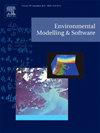Enhancing hydrological modeling of ungauged watersheds through machine learning and physical similarity-based regionalization of calibration parameters
IF 4.8
2区 环境科学与生态学
Q1 COMPUTER SCIENCE, INTERDISCIPLINARY APPLICATIONS
引用次数: 0
Abstract
This study enhances hydrological modeling in ungauged watersheds by employing physical similarity and machine learning-based clustering for regionalizing the Soil and Water Assessment Tool (SWAT) model parameters at the HUC12 (hydrological unit code) watershed scale within a HUC02 basin. Eleven features, including environmental, topographical, soil, and hydrological properties, were utilized to identify physical similarities for watershed clustering. Machine learning techniques, including random forest and hierarchical clustering, were employed to transfer calibrated parameters from gauged to ungauged watersheds. Validation of parameter transfer over gauged SWAT model projects showed that 88% of the projects achieved calibrated status (KGE ≥0.5; PBIAS ≤25%). Additional validation using MODIS satellite evapotranspiration measurements confirmed the robustness of the approach. Results indicated that the proposed approach successfully captures physical similarities, and effectively captures flow patterns. Overall, the study highlights the potential of physical similarity-based clustering and machine learning techniques for improving hydrological modeling in ungauged watersheds.
求助全文
约1分钟内获得全文
求助全文
来源期刊

Environmental Modelling & Software
工程技术-工程:环境
CiteScore
9.30
自引率
8.20%
发文量
241
审稿时长
60 days
期刊介绍:
Environmental Modelling & Software publishes contributions, in the form of research articles, reviews and short communications, on recent advances in environmental modelling and/or software. The aim is to improve our capacity to represent, understand, predict or manage the behaviour of environmental systems at all practical scales, and to communicate those improvements to a wide scientific and professional audience.
 求助内容:
求助内容: 应助结果提醒方式:
应助结果提醒方式:


